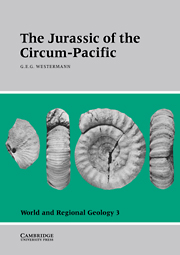Book contents
- Frontmatter
- Contents
- List of contributors
- Preface
- Acknowledgments
- Introduction
- Part I Time scales
- Part II Circum-Pacific base map
- Part III Regional geology and stratigraphy
- Part IV Biochronology
- 12 Ammonite zones of the circum-Pacific region
- 13 Jurassic palynomorphs of the circum-Pacific region
- 14 Radiolarian biozones of North America and Japan
- 15 Ostracods of western Canada
- 16 Bivalve zones and assemblages of the circum-Pacific region
- 17 Belemnites of the southwest Pacific
- Part V Biogeography
- Part VI Climatology and oceanography
- Appendix: Biochronology and atlas with index and guide fossils
- General Index
- Index of Guide- and Indexfossils
13 - Jurassic palynomorphs of the circum-Pacific region
Published online by Cambridge University Press: 04 August 2010
- Frontmatter
- Contents
- List of contributors
- Preface
- Acknowledgments
- Introduction
- Part I Time scales
- Part II Circum-Pacific base map
- Part III Regional geology and stratigraphy
- Part IV Biochronology
- 12 Ammonite zones of the circum-Pacific region
- 13 Jurassic palynomorphs of the circum-Pacific region
- 14 Radiolarian biozones of North America and Japan
- 15 Ostracods of western Canada
- 16 Bivalve zones and assemblages of the circum-Pacific region
- 17 Belemnites of the southwest Pacific
- Part V Biogeography
- Part VI Climatology and oceanography
- Appendix: Biochronology and atlas with index and guide fossils
- General Index
- Index of Guide- and Indexfossils
Summary
In the Jurassic, the palynomorphs available for study include representatives of eight groups of organisms – cysts of dinoflagellates (Dinophyceae); phycomae and zoosporangia (tasmanitids) of prasinophycean algae; representatives of two groups of colonial algae (Xanthophyceae in freshwater sediments, Chlorophyceae in marine sediments); acritarchs (mostly small polygonomorphs and acanthomorphs, loosely termed “micrhystridia,” but with also some sphaeromorphs, herkomorphs and larger acanthomorphs); scolecodonts; the organic linings of the proloculus and early chambers of foraminifera; and the spores and pollen of higher plants. Of these groups, most serve as paleoenvironmental guides, both in broad terms and as indicators of water depth or degree of shoreline proximity. Only three – dinoflagellates, spores and pollen – are of demonstrated applicability in biostratigraphy; however, preliminary scanning-electron-microscope studies of micrhystridia and researches on foraminiferal linings by R. R W. Stancliffe suggest that these groups will also soon prove utilizable.
Spores and pollen are of particular importance in determining the sequence of non-marine sediments and afford the important secondary asset of enabling firm correlations to be made between non-marine and marine sediments. However, even in the relatively equable world climates of the Jurassic, plants showed a considerable regionality, directly reflected by the distribution (by wind, water or small animals) of their reproductive bodies. Moreover, their taxonomy is presently in a confused state, with many different generic or specific names being applied to virtually identical taxa and with regional preferences for these different names causing difficulties in perceiving such inter-regional similarities as do exist. Nevertheless, spores and pollen are being used very successfully as biostratigraphic tools within regions.
- Type
- Chapter
- Information
- The Jurassic of the Circum-Pacific , pp. 273 - 292Publisher: Cambridge University PressPrint publication year: 1993
- 2
- Cited by



